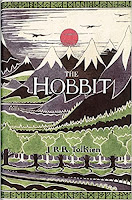 |
| L.M. Montgomery |
Welcome!
Monday, January 17, 2022
Classics Monday - Romanticism, L.M. Montgomery, and Anne of Green Gables
Monday, January 3, 2022
The January Bookish Calendar and Classic Book Monday with a review of The Hobbit
Dear Bookish Friends,
Happy New Year! Another uncertain year lies ahead of us, but one thing that we can be certain of is that there is a wealth of good books out there for ourselves and for the children in our lives. Thank goodness for that!
First of all, as it is the beginning of the month, I would like to direct you to the January Bookish Calendar. Here you will find a calendar on which are noted the birthdays of famous people. Many of these notations have links to books about the people in question. Special days, such as Appreciate a Dragon Day (January 16th), are also on the calendar. As I have a deep fondness for dragons, I shall be sharing several dragon books with you this month.
You will see on this calendar that January the 3rd is J.R.R. Tolkien's birthday. There is a link on the calendar to reviews of books about the author. Thank you, dear man, for your stories, the worlds that you created, and your marvelous characters. In honor of his birthday I bring you a review of The Hobbit on this Classic Book Monday.
What many of you might not know is that Tolkien was an accomplished artist. The image at the top of this page is one of the pieces that he created for The Hobbit. There is a marvelous book, The art of the Hobbit that was published in 2012 in which his art for this book is showcased. I shall be buying a copy of this book for myself today!
J.R.R. Tolkien
Fiction
For ages 10 and up
Houghton Mifflin Harcourt, 2012, 978-0547928227
Bilbo Baggins is very happy with his quiet life in his comfortable hobbit hole under the hill. Meals areoften, abundant, and predictable, and everything is as it should be. He is therefore very discombobulated when Gandalf the wizard appears on his doorstep one day, and he tries to get rid of the disturbing old man as quickly as possible. He is even more horrified when thirteen dwarves and Gandalf arrive for tea the very next day. It would appear that they want Bilbo to join them on an adventure. The dwarves want to get back the treasure that Smaug the dragon stole from them, and they want to hire Bilbo to help them; he will be their "burglar." Bilbo very much wants to refuse this offer, and yet for some confusing reason this fails to happen. Before he quite knows what is happening, Bilbo is riding on a pony, heading off on an adventure which may very well be his undoing.
As it happens, the dwarves are very lucky that they took Bilbo with them for he saves their lives several times over. Not only is he quick thinking and brave, but he also finds a ring of invisibility, which makes it possible for him to do all kinds of remarkable things.
In the end, quiet little Mr. Baggins does indeed fulfill his role as the expedition's burglar. In the process he becomes very fond of a side of himself that he otherwise would never have discovered; he learns that he is able to out-riddle an evil little cave-dwelling monster; he can fight huge spiders; he figures out how to rescue his friends from captivity; and he even talks to a huge dragon. It would appear that Bilbo is more than just an unassuming little hobbit who likes to have his meals on time. That other side of his character helps him rise to challenges that would fell many, and he thus earns the respect and admiration of elves, dwarves, and men alike.
This is a tale that has truly stood the test of time, and it has delighted readers of all ages since its publication in 1937. Tolkien is without a doubt one of the greatest fantasy writers of all time.


